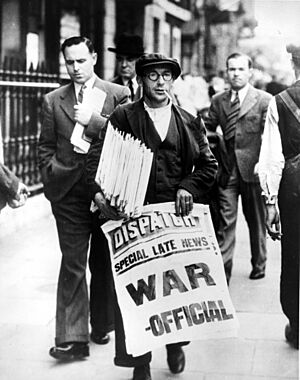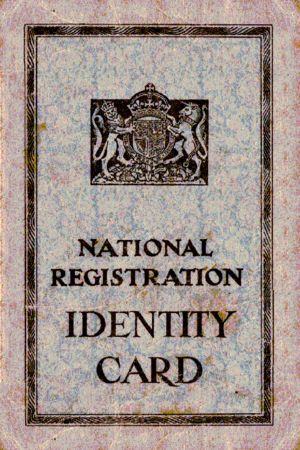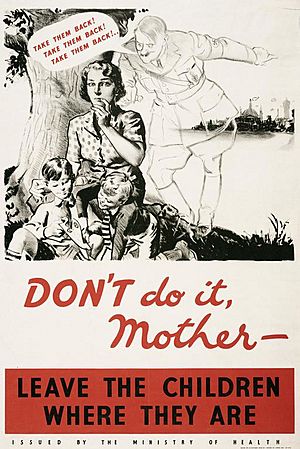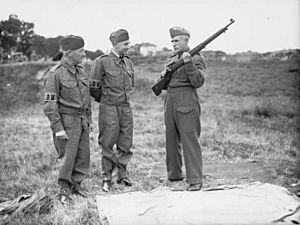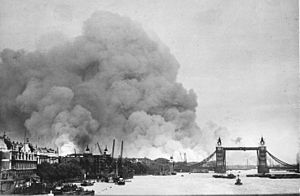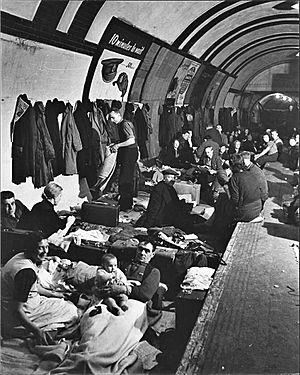Timeline of the United Kingdom home front during World War II facts for kids
This article is a timeline of what happened in the United Kingdom during World War II, from 1939 to 1945. This period is often called the "home front" because it focuses on how the war affected people and life in Britain, away from the battlefields. It covers big changes like rationing, air raids, and how everyday life changed for families and communities.
Contents
1939: Preparing for War
New Rules and Evacuations
- June 3, 1939: The Military Training Act started. This meant that for the first time in peacetime, men aged 20-21 had to join the military for four years.
- August 24, 1939: With Europe in a difficult situation, the British Parliament met. They quickly passed the Emergency Powers (Defence) Act. This law gave the government special powers to make rules during the crisis.
- Army reservists were called up to serve.
- Civil Defence workers, who helped protect people during attacks, were put on high alert.
- August 25, 1939: The National Defence Companies, a group of former soldiers, were called up. Their job was to protect important places.
- August 30, 1939: The Royal Navy, Britain's powerful navy, moved to its war positions. The British Navy was much stronger than Germany's at this time.
- September 1, 1939: Germany invaded Poland. Because of this, Britain started plans to move children, nursing mothers, and pregnant women. They were moved from cities and areas that might be bombed.
- The "Blackout" began. This meant all lights had to be turned off or covered at night. This was to make it harder for enemy planes to see targets.
- The British Army was officially ready for war.
- The government started "Operation Pied Piper." This plan moved over 1.5 million people from cities, including 800,000 children.
Britain Declares War
- September 2, 1939: Prime Minister Neville Chamberlain faced strong criticism. He agreed to give Adolf Hitler, Germany's leader, an ultimatum. This was a final demand before war.
- September 3, 1939: Shortly after 11:00 AM, Prime Minister Chamberlain announced that Britain was at war with Germany.
- Twenty minutes later, the first air raid sirens sounded in London. It was a false alarm.
- Chamberlain changed his government. He created a small "War Cabinet." Winston Churchill joined this cabinet as the First Lord of the Admiralty, in charge of the Navy.
- The National Service (Armed Forces) Act was passed. This meant all men aged 18-41 could be called up for military service.
- September 7, 1939: The National Registration Act was passed. This introduced identity cards for everyone.
- September 23, 1939: Petrol (gasoline) rationing began. People could only buy a limited amount.
- September 27, 1939: The first war tax was announced. Income taxes went up a lot.
- October 1, 1939: Men aged 20-21 who had not yet registered for military service had to do so.
- October 6, 1939: The "Phoney War" began. After Poland's resistance ended, there was little fighting. Britain and France started economic warfare against Germany.
- November 1939: London schools started to reopen. Many evacuated children were returning to the capital.
1940: The Blitz and Churchill's Leadership
- January 1940: About 35% of London schoolchildren who had been evacuated had returned home.
- January 8, 1940: The first food rationing was introduced. People needed coupons to buy certain foods.
- May to June 1940: Another 160,000 children were moved from London. Children near dangerous coastal areas were also moved.
- During this time, Winston Churchill gave famous speeches in Parliament. These included "Blood, toil, tears, and sweat" and "We shall fight on the beaches."
- May 7, 1940: A debate about military failures in Norway led to Neville Chamberlain's resignation.
- May 10, 1940: Germany invaded France and other countries. This ended the "Phoney War."
- Winston Churchill became Prime Minister. He formed a government that included all major political parties.
- May 12, 1940: German and Austrian men aged 16-60 were interned (held in camps). This started with those living near the south and east coasts.
- May 14, 1940: Anthony Eden, a government minister, asked for volunteers to form the "Local Defence Volunteers" (LDV). This group was later renamed the Home Guard on July 23.
- May 22, 1940: The Emergency Powers (Defence) Act 1940 was passed. This gave the government even more power to control people and property during the war.
- June 10, 1940: Italy declared war on Britain.
- Italian men aged 17-60 were arrested and interned.
- Large groups of people attacked Italian businesses and families in several British cities.
- June 19-28, 1940: About 25,000 refugees from the Channel Islands arrived in England.
- June 30, 1940: Germany began its occupation of the Channel Islands.
- July 1940: Another 60,000 schoolchildren were moved from London and nearby areas.
- July 3, 1940: Cardiff was bombed for the first time.
- July 6, 1940: Plymouth was bombed for the first time.
- July 9, 1940: The official start date of the Battle of Britain.
- July 10, 1940: A new rule, Defence Regulation 58AA, was introduced. It allowed the Minister of Labour to ban strikes and force disagreements to be settled by an independent person.
- July 21, 1940: The ship SS Anselm left Liverpool for Canada. It carried the first group of 82 children being evacuated overseas.
- August 25, 1940: The first major air raid on central Birmingham.
- August 28, 1940: The first major air raid on Liverpool.
- August–October 1940: The German "Blitz" hit London and other major cities. This caused many deaths and a lot of damage. Despite the danger, most people remained calm and resourceful.
- September 7, 1940: German bombing raids began on South London. This was the formal start of the London Blitz.
- September 18, 1940: The ship SS City of Benares, heading for Canada, was sunk. 77 of the 90 evacuated children on board died. This led to the end of the overseas evacuation scheme.
- October 31, 1940: The official end date of the Battle of Britain.
- November 14, 1940: A massive German bombing raid hit Coventry.
- November 24, 1940: The first major air raid on Bristol.
- December 12, 1940: A major raid on Sheffield.
- December 20, 1940: A major raid on Liverpool.
- December 22, 1940: The first major raid on Manchester.
1941: Rationing and New Rules
- January 21, 1941: The Communist newspaper Daily Worker was banned. It had ignored warnings about its anti-war stance. When Germany invaded Russia in June 1941, the newspaper became pro-war and the ban was lifted.
- March 13 and 14, 1941: Major air raids destroyed most of Clydebank.
- April 20, 1941: 34 firefighters were killed in the Old Palace School bombing. This was the largest loss of firefighters in English history.
- May 10, 1941: The last major attack on London of the 1940-41 Blitz.
- June 1, 1941: Civilian clothing was rationed for the first time.
- December 18, 1941: The National Service (No. 2) Act was passed. This meant all men aged 18-60, and unmarried women and childless widows aged 20-30, could be called for national service. This included military service for those under 51.
1942: American Troops and New Ideas
- January 23, 1942: The first US Army troops arrived in the UK. They landed in Belfast. Their job was to defend Northern Ireland and free up British troops for fighting overseas.
- March 5, 1942: The Daily Mirror newspaper published a cartoon that Winston Churchill and other government figures said hurt public morale. The government considered banning the newspaper but faced strong opposition.
- April 23, 1942: The "Baedeker Blitz" began. German bombers targeted historic and culturally important English towns like Exeter, Bath, and Canterbury. These attacks continued until June 6.
- July 1, 1942: The basic petrol ration for civilians was stopped. This meant private car owners could no longer buy fuel.
- November 15, 1942: Church bells rang across the UK for the first time since May 1940. This celebrated the victory at the Second Battle of El Alamein in North Africa.
- December 1, 1942: Sir William Beveridge's report on "Social Insurance and Allied Services" was published. This report suggested big changes to social welfare in Britain.
1943: Work and Evacuations
- February 18, 1943: The House of Commons voted against immediately putting the Beveridge report into action. The government agreed with the plan "in principle" but wanted to wait until the war was over.
- April 12, 1943: The government announced its budget. It was £5.8 billion, with most of it raised from taxes.
- July 29, 1943: Labour Minister Ernest Bevin announced that women aged 19-50 would be called to work in plane and munitions factories. Men who could join the military could choose to work in coal mines instead.
- December 14, 1943: The first of 33 fortnightly draws began. This was for the compulsory recruitment of men to work in coal mining. These recruits were known as "Bevin Boys".
- December 20, 1943: Villages in the South Hams area of Devon were forced to evacuate. This was to create a training area for the planned D-Day landings. Some villages, like Imber and Tyneham, were never allowed to return home.
1944: New Threats and Preparations
- January 21, 1944: The "Baby Blitz" began. This was a German night bombing campaign against southern England. It continued until May 1944.
- March 10, 1944: R.A. Butler's Education Act was passed. This law reorganized Britain's school system.
- April 22-28, 1944: During "Exercise Tiger," a training exercise for the D-Day landings, a German attack on April 28 killed 746 US Army and Navy servicemen.
- June 12, 1944: The first V-1 flying bomb attacked London. These were unmanned "doodlebugs" that caused a lot of damage.
- July to September 1944: The final wave of evacuations, called "Rivulet," moved children from London to the English Midlands and West Country.
- September 8, 1944: The first V-2 rocket attacked London. These were much faster and harder to stop than the V-1 bombs.
- September 17, 1944: The full "Blackout" was replaced by a partial "dim-out." This meant some lights could be used.
- September 22, 1944: Ernest Bevin announced the government's plan for soldiers to return home after the war.
- December 3, 1944: The Home Guard was officially stood down. Their job was done.
1945: Victory and New Beginnings
- February 1, 1945: Part-time members of the National Fire Service were stood down.
- March 27, 1945: The last V-2 rocket attack on London.
- March 29, 1945: The last V-1 flying bomb attack on London.
- May 2, 1945: The Civil Defence Service was stood down.
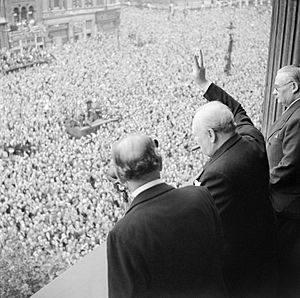
Winston Churchill waving to crowds in Whitehall on Victory in Europe Day, May 8, 1945.
- May 8, 1945: VE Day! This marked the end of the war in Europe.
- May 9, 1945: The German-occupied Channel Islands were freed.
- May 23, 1945: Labour Party members left the government to prepare for an election. Churchill formed a temporary government.
- June 16, 1945: The Family Allowances Act was passed. Mothers would receive a tax-free payment for each child. This was the first time a state payment went directly to a wife.
- June 18, 1945: Soldiers began to return home from the armed forces.
- July 5, 1945: The general election took place in the UK. Ballots were sealed for three weeks to count votes from soldiers overseas.
- July 26, 1945: The Labour Party won the general election by a huge amount. Clement Attlee became the new Prime Minister.
- August 15, 1945: VJ Day! This marked the end of World War II.
See also
- Mass Observation

All content from Kiddle encyclopedia articles (including the article images and facts) can be freely used under Attribution-ShareAlike license, unless stated otherwise. Cite this article:
Timeline of the United Kingdom home front during World War II Facts for Kids. Kiddle Encyclopedia.



